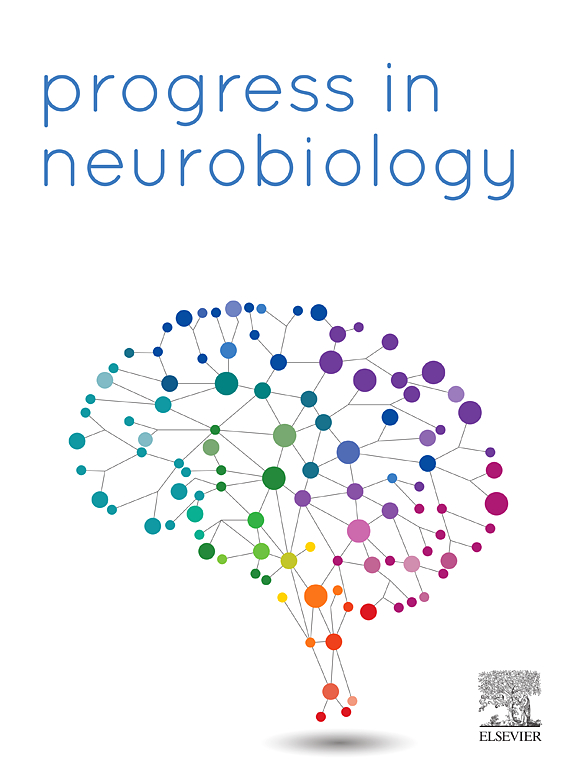通过丘脑皮质神经元实时直接去极化双向控制广泛性缺失癫痫网络。
IF 6.1
2区 医学
Q1 NEUROSCIENCES
引用次数: 0
摘要
以双侧峰波放电(SWDs)为特征的失神性癫痫(ASs)是特发性全身性癫痫的一个标志。我们利用光遗传学技术在自由行为的GAERS大鼠(一种成熟的AS模型)中研究了丘脑皮质(TC)神经元在AS的产生和终止中的作用。我们证明,在安静清醒(QW)期间,腹基底丘脑核中chr2转染的TC神经元的直接去极化可靠地引发了与自发asa相似的持续时间和频率的乙氧亚胺敏感asa,而在活跃清醒(AW)和慢波睡眠(SWS)期间分别显示很少或没有影响。在非癫痫对照(NEC)大鼠中,光刺激TC神经元在AW、QW和SWS期间不能诱发ASs,而在Wistar大鼠中,光刺激可以诱发短ASs,主要在QW期间。值得注意的是,短暂的光刺激有效地阻止了GAERS大鼠(即SWD和静止)正在进行的自发性ASs,立即改变丘脑多单位活动,从有节奏的到不规则的放电,而不管它是在哪个SWD阶段传递的。这些发现支持了以下观点,即皮质-丘脑-皮质网络的兴奋性是高度依赖行为状态的,在QW期间对诱导ASs的易感性增加,因此质疑TC神经元在这些癫痫发作的产生中是否需要低阈值爆发放电。此外,他们强调了TC神经元对as的双重控制,强调了它们作为as调节的治疗靶点的潜力。本文章由计算机程序翻译,如有差异,请以英文原文为准。
Bidirectional control of generalized absence epilepsy networks via real-time direct depolarization of thalamocortical neurons
Absence seizures (ASs), characterized by bilateral spike-and-wave discharges (SWDs), are a hallmark of idiopathic generalized epilepsies. We investigated the role of thalamocortical (TC) neurons in the generation and termination of ASs using optogenetic techniques in freely behaving GAERS rats, a well-established AS model. We demonstrate that direct depolarization of ChR2-transfected TC neurons in the ventrobasal thalamic nuclei during quiet wakefulness (QW) reliably elicits ethosuximide-sensitive ASs that have similar duration and frequency to those of spontaneous ASs, while showing little and no effect during active wakefulness (AW) and slow wave sleep (SWS), respectively. Light-stimulation of TC neurons fails to elicit ASs during AW, QW and SWS in non-epileptic control (NEC) rats, whereas it could evoke short ASs in Wistar rats, prevalently during QW. Notably, brief light stimulation effectively halted ongoing spontaneous ASs in GAERS rats (i.e. both SWDs and immobility), immediately altering thalamic multi-unit activity from rhythmic to irregular firing, irrespective of the SWD phase at which it was delivered. These findings support the view that the excitability of cortico-thalamic-cortical network is highly behavioural state-dependent, with increased susceptibility to the induction of ASs during QW, thus questioning the necessity of low-threshold burst firing of TC neurons in the generation of these seizures. Moreover, they highlight the dual control of ASs by TC neurons, underscoring their potential as therapeutic targets for AS modulation.
求助全文
通过发布文献求助,成功后即可免费获取论文全文。
去求助
来源期刊

Progress in Neurobiology
医学-神经科学
CiteScore
12.80
自引率
1.50%
发文量
107
审稿时长
33 days
期刊介绍:
Progress in Neurobiology is an international journal that publishes groundbreaking original research, comprehensive review articles and opinion pieces written by leading researchers. The journal welcomes contributions from the broad field of neuroscience that apply neurophysiological, biochemical, pharmacological, molecular biological, anatomical, computational and behavioral analyses to problems of molecular, cellular, developmental, systems, and clinical neuroscience.
 求助内容:
求助内容: 应助结果提醒方式:
应助结果提醒方式:


